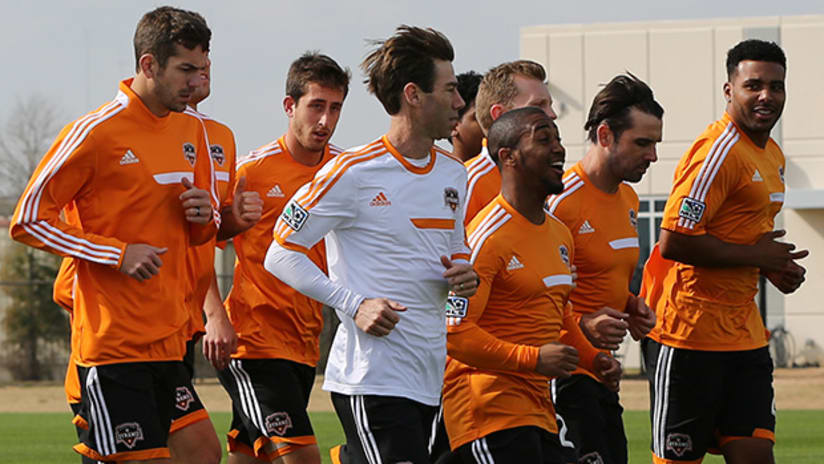With two weeks of preseason training in the books, less than a month remains before the curtain rises on the Dynamo’s 2014 MLS campaign with a March 8 home clash against the New England Revolution.
Preseason is a six-week period with eleven games in three locations spanning from America’s southwest to the east coast: Houston, Tucson and Charleston.
Every time a Dynamo player laces up his boots he is following a training program carefully designed by head coach Dominic Kinnear and his staff to ensure the team is in top gear from the very first kick at BBVA Compass Stadium next month.
Years ago the prevailing attitude was that early preseason training was about getting fit. Some European teams did not even do ball work when the players reported back. Squads were sent to military-style boot-camps where they’d go cross-country running rather than practice passing and dribbling.
That mentality is outdated; today, as standards in MLS keep rising, players are expected to look after their bodies carefully even while on vacation.
“Dom has them leave with the expectation you will show up to camp fit, not coming to camp to get fit. The modern player, obviously they take care of themselves year round,” Dynamo head athletic trainer Theron Enns told HoustonDynamo.com. “A lot of these guys do train in the offseason to maintain fitness. It’s easier to maintain fitness than to have to build it back up.”
Some players are on the job almost year-round, anyway. Tally Hall and Brad Davis were called into the first U.S. World Cup preparation camp of the year. That started on January 6, only 44 days after the last Dynamo game of 2013.
Like pupils given a test on the first day back at school, there is no hiding place for a player who hasn’t done his “homework” during the vacation. “We run our guys through their standard physicals when they arrive,” said Enns.
“That’s a combination of your standard orthopedic screen, a standard medical screen, cardiac for the new guys, concussion baseline testing, but then we also do measurements of body fat, height, weight, those kind of things. We have a general idea of how fit guys are and compare that to last year when they left to see if there’s been any changes.”
As you’d expect from a roster that typically goes deep into the postseason year after year, the levels of professionalism and dedication are high. “Our guys have a good sense of what it takes to keep themselves in shape and Dom’s expectation is that they’ll walk in the door ready to go,” said Enns, a three-time MLS Athletic Trainer of the Year who began his league career with the Colorado Rapids in 1999.
“Dom doesn’t like doing fitness, guys don’t like doing fitness; but in a very measured way we gradually build up how much they do. You notice that most of their early preseason games they go no more than 45 minutes, and in another couple of weeks they’ll go no more than 60 minutes, and ultimately the last game before the season opens, we want our starters and guys to be ready to go 90 minutes. It’s a build-up and obviously this year we only have six weeks to do that.”
Enns said that the coaches employ the concept of “hidden fitness” in preseason, where fitness drills are blended into more enjoyable work such as simulated games.
“You don’t need to do those long runs, the fitness stuff, at the start because the expectation is that you’re going to be in shape ready to play. They get the fitness in some of the small-sided games. Even though it is a soccer game the response to the training is a buildup of cardiovascular fitness and endurance and ‘getting their legs underneath them’, as they say. You can play the games and still get fit, you don’t have to just run. Players hate to just run.”
As anyone who has ever witnessed Kinnear conduct a session can testify, the head coach keeps training intense and efficient and does not waste a minute. “Our guys will practice like they play, it’s short and sharp and it’s quick and it’s at a high tempo. It’s one of the things that’s a hallmark of Dom’s training sessions,” Enns said.
“Some of it’s heat-related, you don’t want to be out there too long. But I think Dom is very quick, very sharp, he doesn’t meander from one drill to the next. Some coaches will take three hours to get a session done because they’re slowly going from one thing to the next but there’s a crisp pace to what the coaching staff has set up here.”
Players often talk about being “match fit” as opposed to simply “fit”. What does that mean? Enns explains: “A lot of guys will run straight ahead in the offseason. Their heart and lungs work great but they don’t start and stop and plant and cut and twist, so there’s different muscles that have to get used to moving around.
“Some of our drills that we do on the side, we’re asking guys to change direction, do things that are going to be more game-like which they may not get on their own at home. Because if they’re by themselves they usually just go for a run, or on the treadmill, or on the bike, or at the park. They’re not stopping, starting, changing direction, because soccer is not a continuous movement sport, it’s a lot of change of direction.”
Kinnear prefers to keep the twists and turns on the field rather than the travel itinerary. In Europe it is common for top clubs to travel abroad each preseason—witness the number of English Premier League teams who visit North America every summer. MLS teams tend to stay on their own continent. That’s natural when you consider that the U.S. offers world-class training facilities and mild winter weather, and MLS teams inevitably rack up the air miles during the season.
This winter, FC Dallas are touring Abu Dhabi, in the United Arab Emirates, and the Los Angeles Galaxy will play a scrimmage in Mexico City against Pumas UNAM. The other 17 MLS clubs are staying in North America. Nine are taking trips to Florida and eleven to Tucson, a one-time hub for Major League Baseball spring training which now seduces MLS teams with the promise of a favorable climate and excellent facilities.
The 2014 Dynamo preseason schedule closely mirrors last year’s arrangements: a few scrimmages at home, three fixtures in Tucson and three in Charleston. In 2012, Houston played games at home, at the Galaxy’s Home Depot Center (now StubHub Center) and in Orlando.
“I like staying in America,” said Kinnear. “I’ve never been a huge fan of traveling outside America. I’ve seen in the past where guys get sick and miss preseason. The competition’s good, it makes things a little bit easier; that’s just me, I don’t know why other teams do it.
“And I always say, if you have some turnover you want to see how good your new players are. I always think to play against the teams or the style of play you’re going to play against during the season is a good idea, so you’re not surprised by it.”
To that end, five of the Dynamo’s eleven fixtures this preseason are against MLS opponents. Houston lost 3-2 to Colorado in a scrimmage at Houston Sports Park on February 2, suffered a 2-0 reverse to the Portland Timbers three days later in Arizona, then beat the San Jose Earthquakes 3-1 last Saturday.
In South Carolina, Kinnear’s men will face D.C. United on February 22, then Seattle Sounders on February 26. “You’re up against competition that’s good, you get to see where your team’s at, and where individuals are at,” he said.
“And also how good your draft picks are doing, because everyone’s going to play and it’s not going to be five minutes, you’re going to get some extended periods of time, so it’s how you handle the pressure, how you handle playing against different types - like, Portland and San Jose play a little bit different, so you see how they match up to different styles of play, different players, and obviously get more fitness and some good results.”
Tom Dart is a contributing writer to HoustonDynamo.com. Former editor and reporter for The Times of London and reporter for SI.com, Dart currently freelances for The Guardian.




